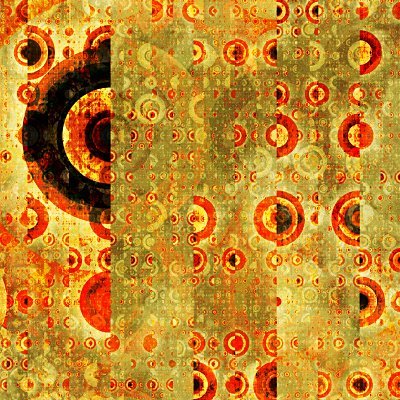Hello !

Hello !
First thanks to the organizers for the invitation. :-) Here is an image I did for the occasion... because I don't fractal much these times and the few unpublished images I had done went away with my laptop (stolen...). :-(
This image is made with the technique I've been using since some years now, and which could be called "pattern piling".
The idea is derived from the Perlin algorythm of "FBM" colorings. To get nice FBM clouds that look random, the Perlin algorythm choose a random but continuous function (understand "pattern") on the plane. Then, it chooses a second one, scales it by 2 (make it look twice "smaller" if you want), and adds it to the first one, with some weight. And it goes on like this. It eventually yields a pattern that display structure on a wide scale range (just because the result is the sum of many patterns of different scales).
The function choosen in the Perlin algorythm is such that you get these smooth FBM clouds. But nothing prevents you to replace this function or pattern by more fancy ones, even preferably with discontinuous functions. If you do this (with some good amount of twisting...) you get the kind of image displayed above.
I think the first person to use this method (not counting usual FBM) was Mark Townsend, with Grievance (or maybe he made some other before not displayed on his site... Mark ?). Later I modified my FBM coloring to make it able to use many different basic patterns. I'm now using the third version of this coloring. I didn't make it public, mainly because a good part of the "art" goes into finding the patterns. I've some further ideas for developing it, but the current sequential way of programming in UF makes them impossible to concretize... I'm waiting for UF5... :-)
Maybe some words about me : I'm 25, doing a Ph.D. in theoretical physics in Geneva (no, not at CERN...). I started fractals around 1996 with a primitive home-made program, and switched to UF in 1998. I'm not really fractalling anymore, just an image here and there, so I'm not so sure, I'll be able to respect the one post in a month rule, but we'll see.
Anyway, nice to be here !
BTW, do someone know why the jpg algorythm completely blurs any bright red area, and if there is some cure ? I noticed it years ago but apparently no improvment in sight... I like bright red !!




6 Comments:
Marvellous image. I really like these kinds of geometric patterns. They have such incredible depth and detail to them. There's also a sort of dreamlike quality to them.
Nice explanation of how the image was made too. I wish more artists would talk about that.
I remember seeing an image called "The Draftsman" on Paul DeCelle's site. It changed my whole perspective on fractal art. These sorts of patterned images look so different and have such richness to them.
Thanks for the beautiful artwork. I guess you'll be pretty busy doing a Phd in Theoretical Physics, but I hope you get some time to make a few fractal images too.
8/13/2006 9:14 PM
About the jpg thing. I don't know why jpgs do that, but I've noticed it too, and not just with bright red, but also with any other bright saturated color.
What I do is use Irfanview to produce and indexed png. The indexing reduces the file size. If you choose 256 colors then the gradients should look okay.
I use Irfanview to do this because it has the best dithering algorithm I've ever seen. Makes very nice images and also preserves color tones better than jpg.
8/13/2006 9:49 PM
Hi Tim !
Thanks ! :-) The wealth of details is also what I like in such images. Somehow each image is a whole universe... About "The Draftsman" it uses pattern piling too, indeed (and maybe even one of my colorings if I remember well :-P).
And thank you too for the comment on jpg. I'll try this Ifranview trick !
8/14/2006 4:45 AM
I'm glad to finally know why jpg does that. Maybe because it was developed for photography, it's not the perfect image format for all digital work.
I use the GIMP for making jpgs. It allows for (I'm not a programmer or math person) "1x1, 1x1, 1x1" sub-sampling, which always makes for clearer images (and significantly bigger file sizes) and reduces the cloudy red rotting effect. Perhaps this is the same subsampling option Garth is referring to.
The GIMP is freeware, open-source too. Of course, if you have Photoshop it probably does all that too. I'm too cheap to buy Photoshop.
8/14/2006 10:21 AM
Yes Tim, that's the right option--all the channels need the same resolution.
JPEG images are actually run through a fairly complex, multi-step process. One of those is that although many images stored in JPEG format are RGB images, JPEG compresses color images in a YCbCr color space. In practical terms, this YCbCr separates the brightness (Y) from the color (CbCr) so that each can be treated differently, but the CbCr isn't quite so good at handling super-strong reds. These rarely occur in real photos, and that's exactly what JPEG was created for. JPEG stands for Joint Photographic Experts Group; their task was to come up with a data compression standard for real-world images.
8/14/2006 10:19 PM
Well he didn't even get into the bit about how the continuous-but-randomish original Perlin noise basis function works, which is probably just as well...
8/16/2006 5:10 PM
Post a Comment
<< Home